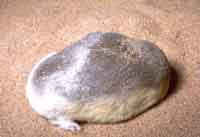Afrosoricida
| Afrosoricida Temporal range:
| |
|---|---|

| |
| Lesser hedgehog tenrec (Echinops telfairi) | |

| |
| Grant's golden mole (Eremitalpa granti) | |
| Scientific classification | |
| Domain: | Eukaryota |
| Kingdom: | Animalia |
| Phylum: | Chordata |
| Class: | Mammalia |
| Mirorder: | Afroinsectivora |
| Order: | Afrosoricida Stanhope MJ, Waddell VG, Madsen O, de Jong W, Hedges SB, Cleven G, Kao D, Springer MS, 1998 |
| Subclades | |
|
†Afrodon Chrysochloridea Tenrecomorpha | |

| |
The clade Afrosoricida (a Latin-Greek compound name which means "looking like African shrews") contains the
Naming
Some biologists use Tenrecoidea or Tenrecomorpha as the name for the tenrec-golden mole
Biology
As a rule, tenrecs and otter shrews tend to be small animals varying from 4 cm to 39 cm in length. There is no pronounced body type since they have evolved to occupy a number of small-bodied, faunivorous niches in Madagascar (tenrecines) and mainland Africa (potamogalines). However, certain species bear some ecological similarity to hedgehogs, soricid shrews, or miniature otters. Their coat can vary from smooth to spiny and the coloration of the fur can also vary from brown, gray, to other hues (see for example photos on the ASM library[8]). Most species are also nocturnal and have poor eyesight. Their whiskers are rather sensitive and they can detect very minute vibrations in the ground to locate their prey.
Phylogeny
Traditionally, these two families were grouped with the hedgehogs, shrews and moles in the Lipotyphla. However, there have always been minority opinions suggesting that Tenrecoidea, or at least the golden moles, are not true lipotyphlans. For example, Robert Broom wrote in 1916[9]
that "examination of the skull confirms ... that
Cladogram of living Tenrecoidea
The generally accepted cladogram of living Tenrecoidea is:[12][13]
| Tenrecoidea |
| ||||||||||||||||||||||||||||||||||||||||||||||||||||||||||||||||||||||||||||||||||||||||||||||||||||||||||||||||||
Species
- Infraclass Eutheria: placental mammals
- Superorder Afrotheria
- Clade Afroinsectiphilia
- Clade Afroinsectivora
- Order Afrosoricida
- Suborder Tenrecomorpha (otter shrews and tenrecs)
- Family otter shrews)
- Genus Micropotamogale
- Micropotamogale lamottei)
- Micropotamogale ruwenzorii)
- Genus Potamogale
- Potamogale velox)
- Genus Micropotamogale
- Family Plesiorycteropodidae
- Genus †Plesiorycteropus
- †Plesiorycteropus madagascariensis
- †Plesiorycteropus germainepetterae
- Genus †Plesiorycteropus
- Family Tenrecidae (tenrecs)
- Subfamily Geogalinae(1 species)
- Genus Geogale
- Geogale aurita)
- Genus
- Subfamily Oryzorictinae (24 species)
- Genus Microgale
- Microgale brevicaudata)
- Microgale cowani)
- Microgale drouhardi)
- Microgale dryas)
- Microgale fotsifotsy)
- Microgale gracilis)
- Microgale gymnorhyncha)
- Microgale jenkinsae)
- Microgale jobihely)
- Microgale longicaudata)
- Microgale majori)
- Microgale mergulus)
- Microgale monticola)
- Microgale nasoloi)
- Microgale parvula)
- Microgale principula)
- Microgale pusilla)
- Microgale soricoides)
- Microgale taiva)
- Microgale thomasi)
- Subgenus Nesogale
- Nesogale dobsoni)
- Nesogale talazaci)
- Genus Oryzorictes
- Oryzorictes hova)
- Oryzorictes tetradactylus)
- Genus Microgale
- Subfamily Tenrecinae (5 species)
- Tribe Setiferini
- Genus Echinops
- Echinops telfairi)
- Genus Setifer
- Setifer setosus)
- Genus
- Tribe Tenrecini
- Genus Hemicentetes
- Hemicentetes nigriceps)
- Hemicentetes semispinosus)
- Genus Tenrec
- Tenrec ecaudatus)
- Genus Hemicentetes
- Tribe Setiferini
- Subfamily
- Family
- Suborder Chrysochloridea (golden moles)
- Family Chrysochloridae(golden moles)
- Subfamily Chrysochlorinae(11 species)
- Genus Carpitalpa
- Carpitalpa arendsi)
- Genus Chlorotalpa
- Chlorotalpa duthieae)
- Chlorotalpa sclateri)
- Genus Chrysochloris
- Subgenus Chrysochloris
- Chrysochloris asiatica)
- Chrysochloris visagiei)
- Subgenus Kilimatalpa
- Chrysochloris stuhlmanni)
- Subgenus Chrysochloris
- Genus Chrysospalax
- Chrysospalax trevelyani)
- Chrysospalax villosus)
- Genus Cryptochloris
- Cryptochloris wintoni)
- Cryptochloris zyli)
- Genus Eremitalpa
- Eremitalpa granti)
- Genus
- Subfamily Amblysominae(10 species)
- Genus Amblysomus
- Amblysomus corriae)
- Amblysomus hottentotus)
- Amblysomus marleyi)
- Amblysomus robustus)
- Amblysomus septentrionalis)
- Genus Calcochloris
- Subgenus Huetia
- Calcochloris leucorhinus)
- Subgenus Calcochloris
- Calcochloris obtusirostris)
- Subgenus incertae sedis
- Calcochloris tytonis)
- Subgenus Huetia
- Genus Neamblysomus
- Neamblysomus julianae)
- Neamblysomus gunningi)
- Genus Amblysomus
- Subfamily
- Family
- Suborder Tenrecomorpha (otter shrews and tenrecs)
- Order Afrosoricida
- Clade Afroinsectivora
- Clade Afroinsectiphilia
- Superorder Afrotheria
See also
References
- ^ Simpson, G.G. (1945). "The principles of classification and a classification of mammals". Bulletin of the American Museum of Natural History. 85: 1–350.
- ^ PMID 20406454.
- ^ McDowell, S.B. (1958). "The Greater Antillean Insectivores". Bulletin of the American Museum of Natural History. 115: 1–214.
- OCLC 62265494.
- ^ Stanhope (1998). "Afrosoricida". In Wilson; Reeder (eds.). Mammal Species of the World (3rd ed.). Bucknell University – via bucknell.edu/biology.
- .
- ISSN 1175-5334.
- ^ "tenrec". Image library. American Society of Mammalogists. Retrieved 7 September 2023.
- ^ Broom, R. (1916). "On the structure of the skull in Chrysochloris". Proceedings of the Zoological Society of London. 1916 (3): 449–459. .
- ^
Stanhope, M.J.; Waddell, V.G.; Madsen, O.; de Jong, W.; Hedges, S.B.; Cleven, G.C.; Kao, D.; Springer, M.S. (1998). "Molecular evidence for multiple origins of Insectivora and for a new order of endemic African insectivore mammals". Proceedings of the National Academy of Sciences. 95 (17): 9967–9972. PMID 9707584.
- ^
Douady, C.J.; Douzery, E.J.P. (2003). "Molecular estimation of eulipotyphlan divergence times and the evolution of "Insectivora"". Molecular Phylogenetics and Evolution. 28 (2): 285–296. PMID 12878465.
- ^ a b
Everson, K.M.; Soarimalala, V.; Goodman, S.M.; Olson, L.E. (2016). "Multiple loci and complete taxonomic sampling resolve the phylogeny and biogeographic history of tenrecs (Mammalia: Tenrecidae) and reveal higher speciation rates in Madagascar's humid forests". Systematic Biology. 65 (5): 890–909. PMID 27103169.
- ^ a b
Upham, Nathan S.; Esselstyn, Jacob A.; Jetz, Walter (2019). "Inferring the mammal tree: Species-level sets of phylogenies for questions in ecology, evolution and conservation". PLOS Biol. 17 (12): e3000494. PMID 31800571.
